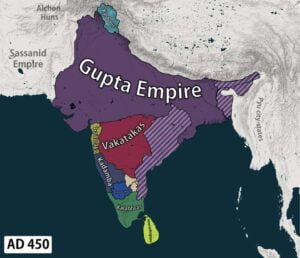Table of Contents
Gupta Empire:- History, Founder, Facts, Timeline, Art and literature
History Overview
At the beginning of the fourth century, India was made up of a number of separate kingdoms. In 320, Chandragupta 1, ruler of Magadha, who was named after the warlike Mauryan ruler, took over the neighboring kingdom to found the Gupta Empire.
Under this successors, the empire expanded to many territories of Today’s India, and became the greatest Asian country of the time, lasting about 150 years.
It was a golden age of Indian painting, architecture, literature, and painting. Also, the Gupta Empire was known for all those 4 things and it’s a rich heritage in those things.
Open Free Demat account
Art and literature of the Gupta Empire
During the time of the Gupta period, Indian artists were much innovative and created some of their best creative works. Magnificent palaces and religious places contained the highest quality art sculpture and paintings.
Classical forms of music and dance, created under the Guptas, are still practiced today all over Asia.
Wall Paintings of the Gupta Empire
30 Buddhist shrines and monasteries are located in the Ajanta hills. Many of these walls were decorated with colorful frescoes or wall painting there.
This was a fashion that continued for hundreds of years. The painting show scenes from the life of the Buddha, and other devotional subjects.
Sculpture of the Gupta Empire
Lifelike sculpture adorned Gupta Shrines and palaces. The most popular subjects were people who had made donations to the shrine, the Buddha and scenes from his life, and people known as Bodhisattva ( those who have reached Buddhist goals of enlightenment and help others to do the same). Many sculptures, such as seated musicians, were made of terracotta.

The golden age of learning of the Gupta Empire
Under the Guptas, universities expanded and became famous for philosophy, medicine, and logic. The Sanskrit language was also developed and was used for major epic stories.
One of the finest writers of the period was Kalidasa, who lived during the reigns of Chandragupta 2 and Kumaragupta. His works include comedies, poems, and heroic plays that are still performed.
Cave Shrines of Gupta Empire
Many of Buddhist cave – shrines in western India were cut out of the cliffs – a task which must have taken years of labor with simple tools the Guptas used.
Cave – shrines are dark and well beautifully decorated with sculptures art and paintings. The Buddha in this example is making the gesture known as Abhaya mudra, or “have no fear”.
How the Gupta empire was run
The Guptas ran their empire as a group of small regions, or sub-Kingdoms. Each subkingdom had its own ruler, but all were under the control of the emperor in Magadha.
The first two Gupta Emperors the empire, while the later Emperors had the task of holding the territory together.
Kings of the Gupta Empire
2) Samudra Gupta:- Chandragupta 1’s son (330- 376) extended the empire into Bengal, central India, and the valleys of the upper Yamuna and Ganges River.
3) Chandragupta 2
Named after his grandfather, the third Gupta had a long and peaceful reign (376 -415 ) during which Indian art and literature began to flourish.
Timeline of the Gupta Empire
320 Chandragupta 1 founds the Gupta Empire
330 – 376 Empire expands from the Indus River to the Bay of Bengal, Under SamudraGupta, and up into the Northern Mountains the Biggest Expansion.
376–415 Chandragupta 2 makes the empire secure, and encourages trade.
415 – 450 Kalidasa composes most of his poetry in the reign of Kumaragupta (415 -455)
450 c. Empire began to collapse due to Invading Huns.
554 The Gupta dynasty ends when the last Emperor dies.
Jay Hind ……!!!!

